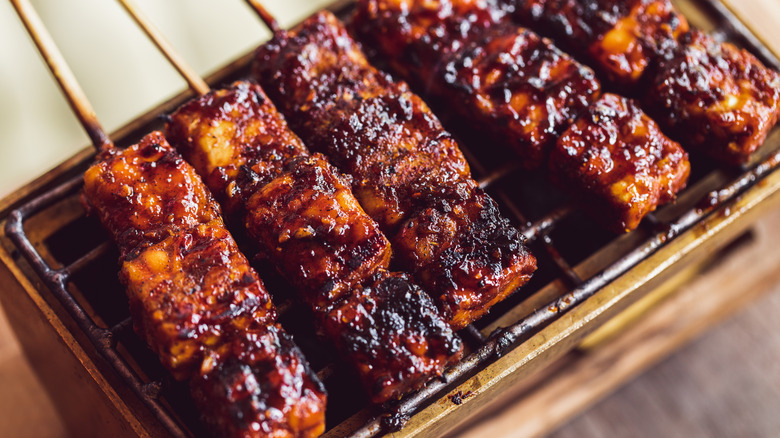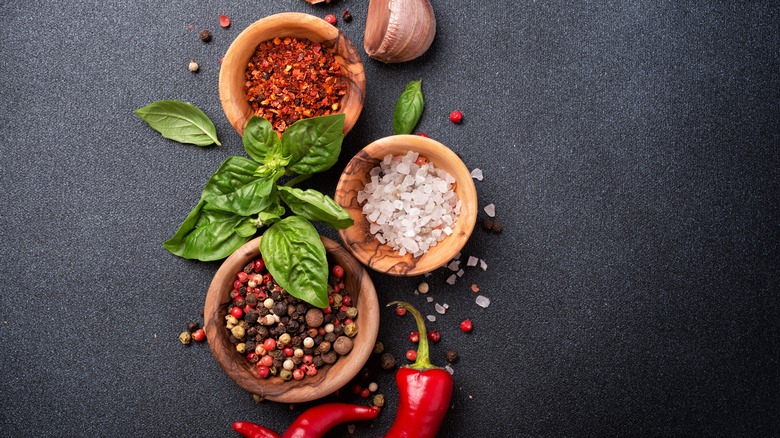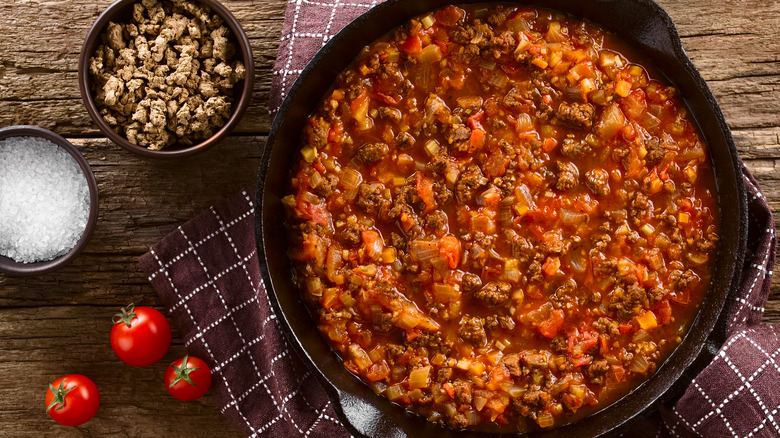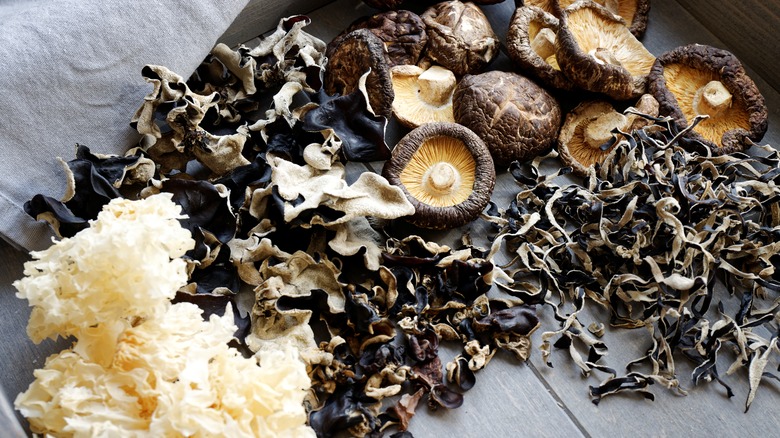11 Tips You Need When Cooking With Plant-Based Meat
Plant-based meat has been rising in popularity for many years — software and data giant Bloomberg estimates that plant-based proteins could make up 7.7% of the global protein market by 2030. If that doesn't sound like a lot, it accounts for a value of over $162 billion. There's no doubt that as plant-based eating becomes more commonplace, so does the demand for plant-based meats.
Plant-based diets have been suggested to reduce your carbon footprint by up to 73%, notes The Independent. Combined with health benefits such as a lower risk of diabetes, cancer, and heart disease, (via World Health Organization), it's easy to see why more and more people are swapping animal protein for plant-based proteins. In this day and age, plant-based meat is made from a wide variety of ingredients — pea protein, wheat protein, and soy protein, to name a few — ensuring a variety of choices.
Behemoths like Beyond have been partnering with restaurants like Denny's, KFC, and TGI Fridays, says Business Insider, while you can now find pioneers like Impossible Meat and Gardein alongside traditional plant-based meat substitutes like tofu and seitan at almost every major grocery store. If you've recently made the move to plant-based eating or aren't confident in the kitchen yet, you may be feeling overwhelmed by the idea of cooking plant-based meat. Don't know which option is best for your recipe? Unsure of how to prepare and season plant-based meat so it's not bland? We've got you covered.
Choose the right plant-based meat for your recipe
First and foremost, it's vital to assess what type of plant-based meat is most suited for the recipe you want to make. Don't think of plant-based meat as 'fake' food, but rather as a substitute. In most cases, you can use plant-based meat like-for-like: plant-based beef mince is great for shepherd's pie, chili, and sloppy joes; plant-based sausages are amazing for English bangers and mash, orecchiette with sausage, or chili cheese dogs; plant-based bacon, on the other hand, is amazing with vegan pancakes, on a BLT, or your breakfast fry-up.
Conversely, more traditional plant-based meat substitutes like tofu and tempeh have been used for centuries in traditional Asian cooking. Per Today's Dietitian, the first written record of tofu was in 950 AD, while the origin of tempeh is suspected to be from pre-1800s Indonesia. Seitan, on the other hand, was a more recent Japanese invention from the '60s. It comes as no surprise then that there are countless Asian dishes utilizing these versatile ingredients, like the famously spicy mapo tofu.
If you're feeling more experimental, tofu can also be used to make creamy plant-based scrambled eggs and rich cheesecakes, while tempeh can convert into bacon and seitan can make for great smoky deli meats. Even whole foods can also make surprisingly convincing plant-based meats with a little extra work, like mushroom bacon or carrot hotdogs! Once you've worked out which option is the best choice for your recipe, let's move on.
Let it marinate to infuse more flavor
While some plant-based meats are already loaded with flavors, others will need a little extra boost to make them the star of the show. Marinating is a great option for plant-based meats like tofu, chick'n shawarma, oyster mushroom scallops, seitan, and plant-based bacon. Anything that will absorb moisture well will be a perfect candidate for marinating.
Traditionally, marinating meat is intended to tenderize, inject flavor, and increase moisture. We add acidic ingredients like vinegar or buttermilk to a marinade to tenderize our protein — these ingredients are also wonderful for elevating and balancing other flavors at play. Illinois Extension notes that oil helps distribute flavor, prevents sticking, and increases moisture. Herbs and spices, the final element for our marinade, is what will help our plant-based meats replicate the flavors we love.
For smoky bacon, try a marinade with smoked paprika, molasses, liquid smoke, and soy sauce. Alternatively, for a fishy taste that will perfectly replicate seafood, try miso paste, lemon juice, and the underrated superfood seaweed. Indian dishes, meanwhile, will benefit from marinating your plant-based meat in vegan yogurt, spices, and oil before adding it to the dish. According to Beyond Meat, plant-based meats should ideally be marinated for a minimum of 30 minutes, and up to overnight. Beyond Meat further stress that you should never marinate your foods in a metal bowl, as you risk the acids in the marinade reacting with the metal and spoiling the taste of your food.
Don't be afraid to give it a good sear
It's not surprising that plant-based meats taste better when they've been seared to golden-brown perfection. Crispy edges and a succulent interior are tantalizing combinations that are known to be the holy grail when cooking protein. But how do we achieve it? The answer: Maillard reactions and caramelization.
According to a 2022 study published in Frontiers in Nutrition, the Maillard reaction is a series of chemical reactions that occurs between amino acids in proteins and reducing sugars. When food is heated to 300 F, the magic begins and the characteristic brown crust emerges. Per the Science of Cooking, caramelization is the process of sugar gradually breaking down due to escaping steam. Caramelization is renowned for creating a complex nutty, rich flavor in desserts and savory dishes.
Make sure you pick the right cookware to sear your plant-based meats — we recommend cast iron as it has excellent heat retention and distribution, both important elements to getting a good sear. As cast iron typically takes a little longer to come to temperature than regular pans, check that it's well-heated before adding your plant-based meat. It's also very important to season your cast iron so as to prevent sticking. You shouldn't be afraid of getting a bit of color on your plant-based meats. In fact, quite the opposite: Almost all foods will benefit from these cooking processes, and plant-based meats are no different.
Season, season again, and season some more
Every chef –- whether professional or home cook –- will agree that seasoning is one of the most important steps when cooking any meal. Seasoning is the best way to create great-tasting food, as it marries the natural flavors of ingredients together to create a cohesive dish.
While general tips like sprinkling seasonings onto your dish from higher up to evenly distribute the flavor throughout the dish still apply to plant-based meats, there is one major difference you should be aware of when seasoning plant-based meat as opposed to animal protein.
While we're used too liberally adding salt to meats like beef, plant-based meat requires a more delicate touch. America's Test Kitchen found that since salt is already added to most plant-based meat during processing, the end product contains a lot more sodium. They suggest that you should use ¼ less salt when working with plant-based meats, and cut down on adding any extra ingredients which contain a lot of salt to your meal. Having said that, this advice only applies to heavily processed plant-based meats. Minimally processed items like tofu, seitan, and tempeh on the other hand don't usually have added salt, so feel free to add sodium-heavy ingredients like soy sauce to improve the flavor.
Don't be shy to experiment with a wide range of herbs and spices to help enhance the flavor of plant-based meat. We guarantee it'll make all the difference.
Add some smoky flavor notes
There's an irresistibly complex smoky aroma that develops through cooking food on a barbecue, grill, or a tandoor oven. According to Smoked BBQ Source, burning wood releases tiny, unburnt particles into the air –- this is what we know as smoke. The variety of wood that's burnt produces different flavors that end up penetrating our food, like sweet, pungent, spicy, and fruity. In short, this is a mouth-watering way to inject more interest into your plant-based meats and make them taste more "authentic."
How do we create that signature smokiness? Two options: cooking methods or seasonings. Firstly, you can use a food smoker, a barbecue grill, or a tandoor oven. If you don't have access to any of these though, no worries. As an alternative, you can harness the power of spices to your advantage.
Using certain spices which have been pre-smoked like smoked paprika or smoked salt is a great way to add depth and complexity to your plant-based meat. Cumin, on the other hand, is a spice that has an inherently smoky profile and can be used whole or ground. Furthermore, molasses, liquid smoke, and Lapsang Souchong (black tea leaves smoked over pine) all contribute deep, dark notes. Use these tips to infuse tofu, soy chunks, or chick'n chunks with a smoky flavor when adding to Indian tikka dishes (tikka is traditionally cooked in a tandoor), or to marinate carrots, mushrooms, tofu, or tempeh to create plant-based bacon.
Make it saucy
The sauce makes everything better. From hot sauce to teriyaki sauce, pasta sauce, and dipping sauce, it's an easy way to maximize flavor and takes your plant-based meats to the next level.
Plant-based meats like mince are prime candidates for cooking in a sauce. A rich ragu cooked with plenty of olive oil, onions, celery, garlic, carrots, herbs, and vegetable stock will help your plant-based mince soak up plenty of flavors while cooking and turn an average meal into something spectacular. Alternatively, try cooking your plant-based mince in an Indian keema sauce or chili con carne which are rich with fresh, fiery spices. Certain plant-based meats like soy curls, tofu puffs, and traditional Chinese seitan have a moderately spongey texture which makes them perfect for soaking up all the scrumptious flavors in the sauce. We recommend cooking these plant-based meat substitutes in Asian-inspired dishes like instant-pot tofu curry or serving in a vegan ramen broth topped with scallions.
On the other hand, plant-based meats like seitan shreds or chick'n pieces that have been marinated with Middle-Eastern inspired spices will taste incredible once charred, then topped with tzatziki sauce –- make it vegan by using coconut, soy, almond, or cashew yogurt. Finally, ready-made plant-based meats like burgers, sausages, and nuggets will all benefit from an incredible dipping sauce drizzled on top. Classic choices like vegan mayo or ketchup are safe bets but bear in mind that Worcestershire sauce is neither vegetarian nor vegan, as it contains anchovies.
Boost the umami
Have you heard of umami? If not, you're not alone. According to Japanese food cooperation Ajinomoto, umami means "essence of deliciousness" in Japanese, likely referring to its indescribable effect of adding complex savory notes to everything it's added to. But what exactly is umami? It's the fifth of our four basic taste groups, alongside sweet, salty, bitter, and sour. This flavor is most often present in meat – The New Yorker describes it as a "deep, dark, meaty intensity" found in foods like mushrooms, meat, and anchovies.
Although plant-based meats generally aren't naturally high in umami, it's a great idea to add umami-rich ingredients to your dish that will help elevate the plant-based meat in both authenticity and delectability. Foods high in umami include shiitake and porcini mushrooms, onions, miso paste, soy sauce, seaweed, ketchup, and truffle.
As we suggested earlier, marinating your plant-based meat is a great way to include more flavor — and as it turns out, many of the ingredients great for marinating are also high in umami. Otherwise, why not experiment with cooking finely chopped mushrooms in tandem with plant-based mince, caramelizing onions to serve with your plant-based burgers, or adding some dried mushroom powder to homemade seitan? You could even add a squeeze of ketchup when you cook plant-based meats in tomato sauces, just to enhance the tastiness.
Don't skimp on the fat
If you've ever cooked meat, you've likely noticed that you can generally cook it with little to no oil. Philips explains that this is because the natural fats inside the meat are enough to cook it. Plant-based meats, on the other hand, don't release fats in the same way and need a little extra help when you fry, grill, or bake them. Don't be afraid of adding a generous glug of olive oil or vegetable oil.
Cooking in oil doesn't just help your plant-based meat develop lovely caramelized edges, but also adds richness and a pleasant mouth-feel. That's because fat helps to distribute seasonings and flavors throughout the food, insuring that every mouthful is just as delicious as the next. Furthermore, fats help to concentrate flavor and aromas through chemicals released into the air while cooking. Making sure that there is adequate oil in the pan also helps prevent sticking, which can be an issue with plant-based meats.
Bear in mind that certain oils are less suitable for cooking at high heat. Extra virgin olive oil is best used in its purest form (think salad dressings and dipping oils), according to the North American Olive Oil Association, it has a smoke-point between 350 F to 410 F. Opt for regular olive oil or vegetable oil instead.
Don't overcook, keep it juicy
One of the main aspects that plant-based meats aim to replicate is texture. Whether that may be succulent, juicy, or tender, there's no denying that texture plays a large part in how desirable and enjoyable our food is.
With scientists working behind the scenes at heavyweight brands like Impossible, Beyond Meat, MorningStar Farms, and Tofurkey, plant-based meats have come a long way in imitating the various textures of real meat. However, that's only half the equation. The rest is up to us, the cooks, and it all lies in how you cook your plant-based meats. So, how can we avoid the dreaded dry, rubbery texture?
The New York Times notes that plant-based burger patties tend to brown quicker than their meat counterparts and suggests forming thicker, more robust patties, then cooking to "medium-rare." As plant-based meats are less fatty and contain less moisture, this ensures that the coconut oil inside the patties doesn't have a chance to dry out. Laura Kliman, director of product development at Impossible Foods, agrees, "Our meat tends to cook faster," she mentioned while talking to The Washington Post.
You don't have to worry about killing bacteria, but you do have to worry about it drying out.
Try making your own plant-based meats
Although nothing can beat the convenience of store-bought plant-based meats, we'd be amiss if we didn't mention the benefits of making your own, too. You can control the ingredients, flavors, and textures to exactly match your preferences and dietary requirements.
Tofu can be made at home by a simple process starting with soy milk. You can buy this at the store, or make homemade soy milk by soaking soybeans in water, then blending and straining them. Next, you'll need to add a coagulant: Traditionally gypsum would be used, although acids like vinegar or lemon juice can work too, (via TofuBud). The soy milk will begin to curdle, at which point you can strain it, then add the flavoring of your choice before pressing to set. It's worth noting that you can control how firm your tofu is by adjusting the amount of coagulant.
Alternatively, you can make Burmese tofu, which is soy-free. It's made by cooking chickpea flour, turmeric, and water until glossy, then pouring it into a tray and leaving it to set. Experiment with spice mixes to make exciting variations. Seitan, on the other hand, is made by mixing vital wheat gluten with flavorings of your choice, working into a dough, steaming, and then either shredding, cutting into nuggets, or making into deli meats. It's perhaps the most versatile homemade plant-based meat, and you can even add tofu to the vital wheat gluten for an extra source of vegan protein.
Don't treat it exactly like meat
Although plant-based meat has come a long way in recent years to win over vegans and omnivores alike, plant-based meat will always be undeniably different from animal meat. Product developers at Impossible Foods have worked out how to make the plant-based burgers 'bleed' just like real meat using a molecule called heme, which allegedly also helps it replicate the taste of meat. Awesome? Yes. But as we've explored in the tips, you still need to bear in mind that plant-based meats cook faster, need more flavoring, don't need to marinate for as long, and will require more fat to cook.
Having said that, these differences can work to the advantage of the home cook. Because plant-based meats take less time to cook and you don't have to marinate them for as long, it means that both food-prep and cooking times are faster in plant-based meals compared to meat or fish. Food Navigator notes that vegan meals are on average 40% cheaper than non-vegan ones, especially if you combine plant-based meats with plenty of whole foods like vegetables and fruits.
Cooking with plant-based meat can help you gain more confidence in the kitchen and present the opportunity to explore the world of spices, experiment with marinades and umami, and test out homemade plant-based meat substitutes. Now you're armed with an arsenal of plant-based meat cooking tips, why not heat your grill and get cooking?











